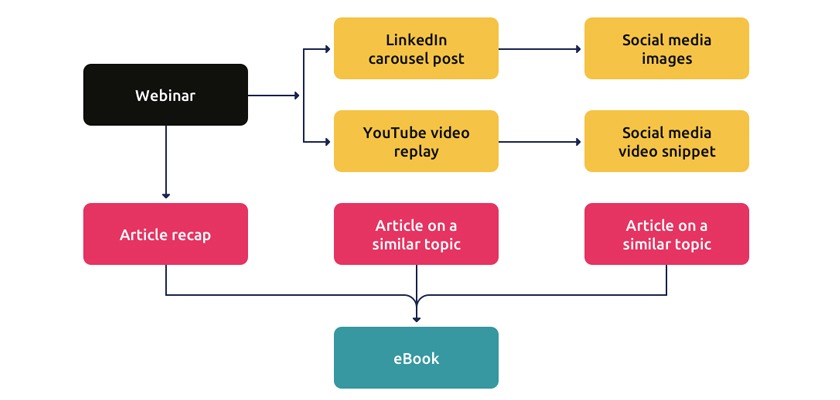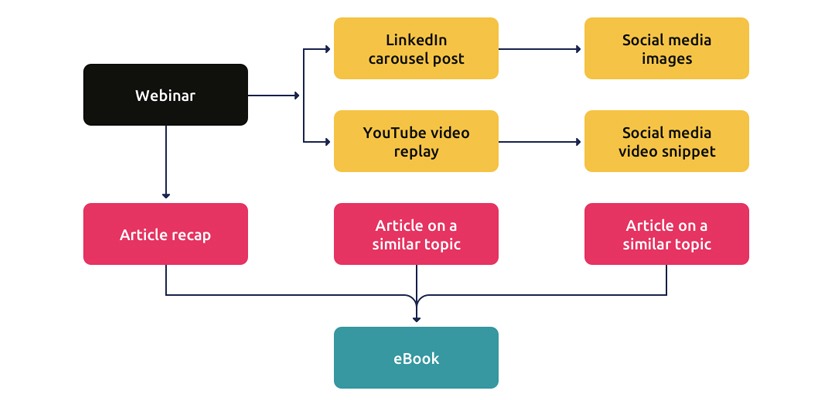
Your customers consume content across multiple platforms, in different formats, and in different mindsets. Re-purposing content can make you ever-present at all touchpoints in your audience’s path to purchase, establishing strong connections that help build brand awareness, sentiment and convert clicks into conversions.
As digital platforms and customer expectations continue to evolve, it can be difficult to get ahead of your audience’s insatiable thirst for fresh content. When aiming for a cost-effective and scalable digital marketing approach, neglecting your content re-purposing strategy is no longer an option.
What Is Content Re-Purposing?
Simply put, re-purposing is the process of recycling content into different formats to increase your publishing options on different platforms. Its purpose is to increase the scope of your marketing material, targeting new audiences who consume content in different ways by presenting them with the same valuable and informative content that has been used to engage your existing customers.
Types of re-purposing include:
- Serialisation of eBook chapters into blog posts (or blog posts into an eBook)
- Case studies into a LinkedIn carousel post
- Taking a podcast transcript and re-working into a blog post or animated video
- Webinar into a SlideShare presentation
- Editing long-form video content into digestible, snackable Instagram Stories, YouTube shorts or TikToks


The Benefits of Incorporating Content Re-Purposing into Your Digital Marketing Strategy
- Time and cost effective: Get more mileage out of your current content investments by reaching new audiences and extending the life of your work.
- Increase content ROI: Optimising your content for multiple platforms increases organic reach and the subsequent return from your content investment, whether this is through Google, YouTube, Spotify, social media platforms or email.
- Audience-centric: By re-surfacing and editing popular content, you are focusing your efforts on material you know already resonates with your target audience, reducing risk and noise.
- De-fragment the customer journey: 73% of customers use multiple channels to help make their purchase decision. Engaging with your audience across these helps to fully connect your customer journey, strengthening engagement and ensuring visibility when it counts.
- Eliminates creative block: Remove barriers to inspiration by fully utilising what is already scheduled in your content calendar.
How to Get Started with Content Re-Purposing
Ideally re-purposing is central to your content marketing and production processes, rather than an afterthought.
- Proactive (embedding content re-purposing into your strategy and production processes): Content repurposing is often thought of as something you consider after creating an initial piece of content. However, it can make sense to create content for different formats simultaneously or concurrently so that the creative work involved doesn’t pile up.
- Reactive (responding to recent successes): Another option is monitoring performance and re-purposing across formats or platforms once you have tested the waters and collected engagement data. This approach best serves organisations with agile creative teams as lead-times may be short to fully capitalise on its success.
- Retrospectively (re-surfacing evergreen content): Finally, there is the option to look further back, auditing your owned media inventory to identify content that has either remained continuously valuable or has enjoyed a popularity resurgence due to macro developments. Use longitudinal engagement data to make your decision, update the asset and then expand the format for wide distribution to your target audience across the platforms they play.
Conclusion
More brands are making eCommerce and digital central to how they do business in response to customer demand. As platforms continue to expand their content formats, the pressure to produce fresh content can overwhelm the most creative and responsive content teams.
By embedding a re-purposing culture at the strategy and initial production phase, you can keep your owned, earned and paid media content calendar full with engaging and time proven material that keeps your audience entertained.


